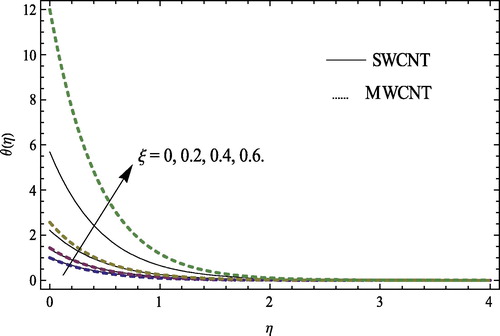Abstract
In nano-medicine, attempts of using the carbon-nanotubes (CNTs) as drug-carriers are undertaken especially in the treatment of cancer. These (CNTs) are first injected into the blood which then reach the tumor cite under the actions of the waves propagated by the walls of the arteries with an external force such as a magnetic field or laser beams. The flow near the boundary of the artery may be treated as a boundary layer flow only for simplification as we consider here. In applied science, the flow and heat transfer of CNTs are usually described by systems of nonlinear differential equations. Due to nonlinearities, the exact solutions of such systems cannot be obtained in most cases. In this paper, an effective analytical procedure is proposed to deduce the exact solution of a system of nonlinear differential equations describing the effect of a convective heat condition on the flow and the heat transfer of carbon-nanotube suspended nanofluids with suction/injection in the presence of a magnetic field. The heat transfer equation is solved via applying Laplace transform and the solution is expressed in terms of the generalized incomplete gamma function. Also, it is proved that the present exact solutions for the flow and the heat transfer reduce to those in literature in the absence of the suction/injection and the convective parameters. The results declare that the temperature profiles are very sensitive regarding the value assigned to the convective parameter. Moreover, the effects of other physical parameters on the studied phenomena are displayed through graphs. Besides, possible applications of the current results have been also discussed.
1 Introduction
Ligima, a Japanese researcher, may be the first to discover the carbon-nanotubes (CNTs) in the beginning of the nineties of the last century. Nowadays, there is an increasing interest in the applications of single-walled nanotubes (SWNTs) and multi-walled nanotubes (MWNTs) in industry and medical fields for their direct impacts on increasing the thermal conductivity of the base fluids. Since the first investigation of Choi (Citation1995), many authors (Khanafer et al., Citation2003; Xue, Citation2005; Aly and Ebaid, Citation2014; Meyer et al., Citation2013; Ebaid et al., Citation2014; Wang et al., Citation2013; Ebaid and Alatawi, Citation2014; Hamad, Citation2011; Khan et al., Citation2013; Noreen et al., Citation2013; Ebaid, Citation2014) have investigated the flow and heat transfer of the regular nano-particles and the carbon-nanotube suspended nanofluids. For examples, in (Hamad, Citation2011) the author examined the natural convection flow of a nanofluid over a linearly stretching sheet in the presence of magnetic field, where four types of regular nanoparticle suspended nanofluids were considered. His work has been extended by Ebaid et al. (Citation2014) by considering the effect of slip velocity in both cases of stretching and shrinking sheets. naFurther, Khan et al. (Citation2013) analyzed the fluid flow and heat transfer of carbon nanotubes along a flat plate with Navier slip boundary condition. They have considered three types of base fluids, the water, the kerosene and the engine oil. In their study, they concluded that the slip parameter reduces the skin friction and increases heat transfer rate. In addition, there is an increase in skin friction and heat transfer rates as the CNT volume fraction increases. Many other useful results have been also presented in Khan et al. (Citation2013). The thermal conductivity of single-wall CNT is about 6600 W/m K, while for multi-wall CNT is about 3000 W/m K (Hone, Citation2004; Antar et al., Citation2012) (). Kamali and Binesh (Citation2010) discussed the convective heat transfer of multi-wall carbon nanotube (MWCNT)-based nanofluids in a straight tube under a constant wall heat flux condition. Recently, two main categories were discussed in detail as the single phase modeling which the combination of nanoparticle and base fluid is considered as a single phase mixture with steady properties and the two phase modeling in which the nanoparticle properties and behaviors are considered separately from the base fluid properties and behaviors. Both single phase and two phase models have been presented in the papers by Sheikholeslami and Ganji (Citation2016), Sheikholeslami et al. (Citation2016a), Sheikholeslamia et al. (Citation2016b), Sheikholeslami and Ganji (Citation2015a), and Sheikholeslami et al. (Citation2015). Although the current model can be dealt with by any of the semi analytical methods as in Sheikholeslami and Ganji (Citation2013), Sheikholeslami et al. (Citation2011), Sheikholeslami et al. (Citation2012a), Sheikholeslami and Ganji (Citation2015b), Sheikholeslami et al. (Citation2014), Sheikholeslami et al. (Citation2012b), Sheikholeslami et al. (Citation2013), Sheikholeslami and Ganji (Citation2014), and Sheikholeslami et al. (Citation2012c), we prefer to analyze the model via an exact analysis.
Table 1 Thermal properties of base fluid and nanoparticles.
For applications in medical field, it may be important to refer to the paper by Ebaid and Aly (Citation2013) in which the importance of the magnetic field in addition to the nano-particles/CNTs were explained to treat the cancerous cells. In such medical application, the nano-particles/CNTs are injected into the blood vessel nearest to the tumor along with placing a magnet close to the tumor (). These particles act like heat sources in the presence of the applied magnetic field, where the cancer’s tissues are destroyed when the temperature reaches 42–45 °C. Additional results on CNTs have been also reported in Noreen and Khan (Citation2014) and Ebaid and Al Sharif (Citation2015). The objective of the present study is to extend the physical model of Ebaid and Al Sharif (Citation2015) by considering the effects of the parameters of first and second-slips, the convective heat condition and the suction/injection. An analytical approach based on Laplace transform is used to establish a new exact analytical solution for the heat transfer equation of CNT-suspended nanofluids. Moreover, it is proved in this paper that the present solutions for the flow and the heat transfer reduce to those obtained by Ebaid and Al Sharif (Citation2015) in the absence of all of the current added parameters. The paper is ended by a physical discussion where the obtained exact solutions are invested to conduct some numerical results for the effects of various parameters on the involved phenomena.
2 The mathematical model
Details of PDEs describing the flow and the similarity transformations can be found in Hamad (Citation2011), they were not mentioned in this paper to avoid repetition. Accordingly, the flow and the heat transfer of an incompressible viscous nanofluids with carbon-nanotubes past a linearly semi-infinite stretching sheet under the influences of a constant magnetic field and suction/injection is finally governed by the following system of nonlinear differential equations:(1)
(2) where
(3)
(4)
The primes denote the differentiation with respect to a similarity variable . f and
are the dimensionless stream function and temperature, respectively,
is the solid volume fraction of the CNTs,
and
are densities,
and
are the heat capacitances, M is the magnetic parameter, Pr is the Prandtl number, and
is the thermal conductivity defined as follows (Ebaid and Aly, Citation2013)
(5) where
and
are the thermal conductivities,
and
denote the basic fluid and solid fractions, respectively. The flow is subject to the boundary conditions:
(6)
(7) where
is the suction/injection parameter, (
) is the slip parameter of first-order, and (
) is the slip parameter of second-order. Details of the Eqs. (6) can be found in Aly and Ebaid (Citation2013a,Citationb), they were not mentioned here to avoid plagiarism. Following Ebaid and Al Sharif (Citation2015), thes exact olution for the stream function
can be obtained as,
(8) where
(9) and the
is governed by the algebraic equation:
(10)
It should be noted that in the absence of the suction/injection, i.e, and as
/no slips, the solution given by Eqs. (8)–(10) reduces to the stream function obtained by Ebaid and Al Sharif (Citation2015). Inserting Eq. (8) into Eq. (2), yields
(11)
In the next section, we discuss the effectiveness of the Laplace transformation to derive an analytical expression of the temperature in terms of the generalized incomplete gamma function.
3 Application of Laplace transform
Since Eq. (11) is a second-order linear ODE with variable coefficients of exponential type, i.e., non-polynomial, it may be difficult to solve it (in the present form) neither by the power series method nor by Laplace transform, especially, in the presence of the infinity boundary condition (7). For that reason, it may be first suitable to transform Eq. (11) to polynomial type coefficients using the independent variable (Ebaid and Al Sharif, Citation2015). Hence, Eq. (11) becomes
(12) subject to the following set of transformed boundary conditions
(13)
Eq. (12) became a linear ODE with variable coefficients of polynomial type and can be put in the following simplest form(14) where
(15)
Taking Laplace transform to both sides of Eq. (14), it then follows(16) where
is the Laplace transform of
, i.e.,
. Note that the first transformed boundary condition
was implemented to conduct the last equation. Integrating Eq. (16), we obtain
(17) where c is a constant of integration. In order to apply the inverse Laplace transform
on Eq. (17), a restriction should be made here on m which is
, hence
(18) where
denotes the convolution property defined by
(19) such that
and
. Accordingly, Eq. (18) becomes
(20)
(21)
(22)
By implementing the second transformed boundary condition , the constant c is given as
(23)
Therefore, is given in the following exact form
(24)
In terms of we have
(25)
The solution obtained in Eq. (25) can be checked by substitution into Eq. (2). Here, we point out not only to the simplicity of the current analytical procedure when compared with that followed by Hamad (Citation2011) but also to the simpler expression of the exact solution given by Eq. (25). Indeed, such simplicity in the solution form facilitates the derivation of the numerical results, through a software program.
4 Discussions
Before going to the discussion, it may be important to refer to that the restriction is of no physical meaning and it is just a relation between the impeded parameters to ensure the existence of the temperature solution. To confirm this point, the values of m are calculated and listed in at the selected parameters in the caption of as an example. It is noted from this table that the values of m are always less than unity.
Figure 3 Temperature profiles of SWCNT/MWCNT–water nanofluid for various values of ϕ at M = 1, fw = 1, λ = 1, λ = −1, ε = 0.05.
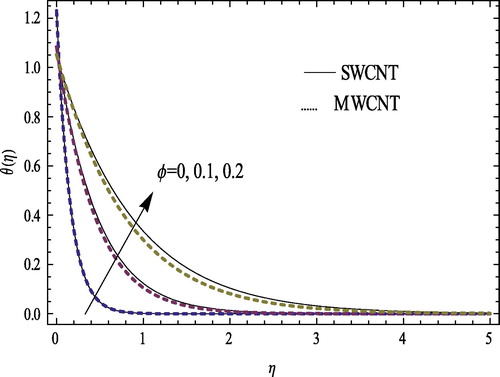
Table 2 The values of the parameter m at some selected parameters.
is depicted to get information about the effect of the solid volume fraction parameter on the velocity of the SWCNT and MWCNT suspended nanofluids. It is clear from this figure that the fluid velocity increases with increasing the
parameter. Also, teaches us that the MWCNT-suspended nanofluids have higher velocities than the SWCNT-suspended nanofluids and this may be useful in industrial applications as well as medical applications. For example, in treatment of cancer the preceding analysis reveals that the MWCNTs may be faster than the SWCNT nano-particles in reaching the cite of tumor. A well known result in the field of nanofluids is the increase in temperature with adding more nano-particles to the base fluids. This is because with increasing
the thermal conductivity of the base fluid increases. Such result is also confirmed for the CNTs as declared in . Besides, shows that the SWCNT-nanofluids are of higher temperature over the MWCNT-nanofluids. This the same conclusion of the authors in Noreen and Khan (Citation2014). The results presented in for the effect of the first slip parameter
on the variation of the velocity reveal that
is a decreasing function in
. Moreover, the MWCNT-nanofluids are of higher velocities than the SWCNT-nanofluids which agrees with the results of .
Figure 2 Velocity profiles of SWCNT/MWCNT–water nanofluid for various values of ϕat M = 1, fw = 1, λ = 1, δ = −1.
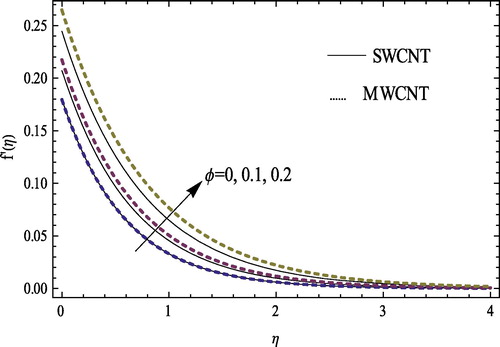
Figure 4 Velocity profiles of SWCNT/MWCNT–water nanofluid for various values of λ at ϕ = 0.1, M = 1, fw = 1, δ = −1.
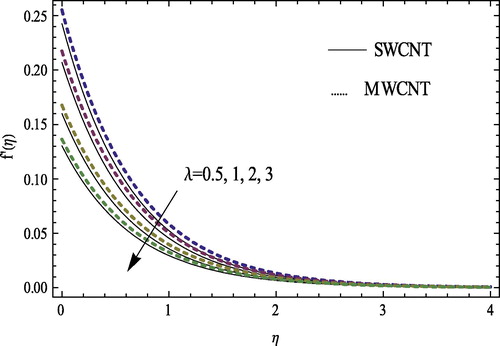
The effect of the first slip parameter on the variation of temperature is displayed in at a certain value of the convective parameter
. indicates an increase in the fluid temperature with increasing the
parameter. Note that the results above have been obtained in the presence of the magnetic parameter M. Such magnetic field may accordingly act as a heat source in the presence of SWCNT-nanoparticles. also shows the effect of the first slip parameter
on the variation of temperature at another value of the convective parameter
. Although the concavity of the temperature curves are changed from down in to above in , however, the temperature is still increased by increasing
with the recognition that the concavity of the temperature curves is very sensitive regarding the value of
.
Figure 5 Temperature profiles of SWCNT–water nanofluid for various values of λ at ϕ = 0.1, M = 1, fw = 1, λ = −1.
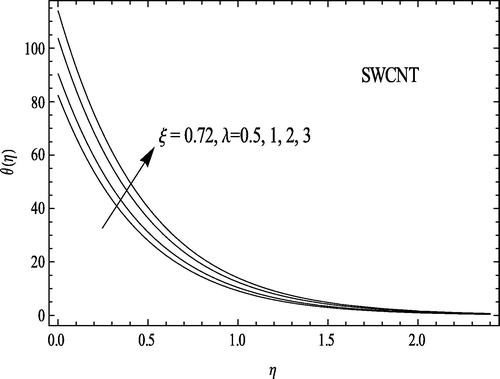
Figure 6 Temperature profiles of SWCNT–water nanofluid for various values of λ at ϕ = 0.1, M = 1, fw=1, λ = −1.
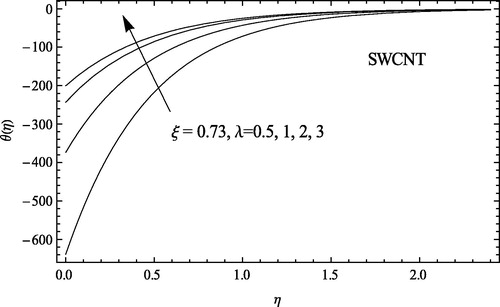
and depict the effect of the second slip parameter on the variation of temperature for the SWCNT-nanofluids and the MWCNT-nanofluids respectively at the same set of the parameters values. It can be shown from these two figures that the increase in the second slip parameter
leads to the increase in the temperature of both types of the CNT-nanofluids. However, the SWCNT-nanofluids are greatly affected by the variation of
than the MWCNT-nanofluids.
Figure 7 Temperature profiles of SWCNT–water nanofluid for various values of δ at ϕ = 0.1, M = 1, fw = 1, λ = 1.
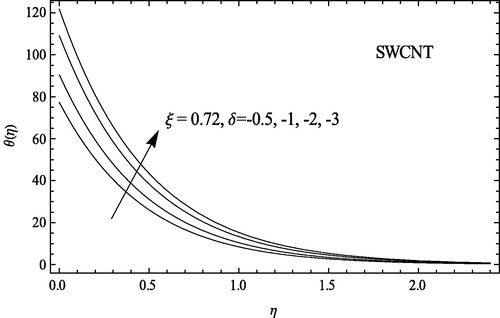
Figure 8 Temperature profiles of SWCNT–water nanofluid for various values of δ at ϕ = 0.1, M = 1, fw = 1, λ = 1.
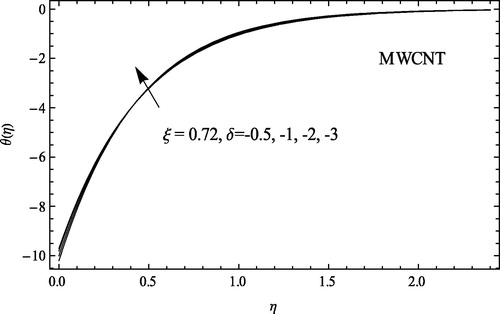
Regarding the effect of the convective parameter on the variation of the temperature, one can see from that the temperature increases by increasing
. Moreover, the MWCNT-nanofluids are of higher temperature over the SWCNT-nanofluids. However, in the absence of the first and the second slip parameters and the convective parameter
as in Noreen and Khan (Citation2014) the results revealed that the SWCNT-nanofluids are of higher temperature over the MWCNT-nanofluids. Such current behavior for the temperature confirms the importance of the current study which opens the door to more future studies by taking into account the effects of the first slip parameter
, the second slip parameter
, and the convective heat parameter
. As a final note of the present study is that a simple analytical procedure is recommended to analyze similar problems without resorting to any of the approximate numerical approaches which have led to uncorrect physical interpretations in many cases, see please Ebaid (Citation2014), Ebaid and Alatawi (Citation2014), and Ebaid and Aly (Citation2013).
5 Conclusion
The flow and heat transfer of CNTs are usually described by systems of nonlinear differential equations. An effective analytical procedure is proposed in this paper to deduce the exact solution of the mathematical model describing the effect of a convective heat condition on the flow and the heat transfer of carbon-nanotube suspended nanofluids in the presence of suction/injection. It is also proved that the current solutions reduce to those in literature in the absence of the suction/injection and the convective parameters. It was found that the temperature profiles are very sensitive regarding the value assigned to the convective parameter. Moreover, the MWCNT-nanofluids are of higher temperature over the SWCNT-nanofluids. However, in the absence of the two slips parameters and the convective parameter, the SWCNT-nanofluids are of higher temperature over the MWCNT-nanofluids. This confirms the importance of taking into account the effects of the first slip parameter, the second slip parameter, and the convective heat parameter in future works.
Conflict of interest
The authors declare that there is no conflict of interest regarding the publication of this paper.
Acknowledgment
The authors would like to acknowledge financial support for this work from the Deanship of Scientific Research (DSR), University of Tabuk, Tabuk, Saudi Arabia, under Grant No. S–0287–1437.
Notes
Peer review under responsibility of University of Bahrain.
References
- E.H.AlyA.EbaidExact analytical solution for suction and injection flow with thermal enhancement of five nanofluids over an isothermal stretching sheet with effect of the slip model: a comparative studyAbstr. Appl. Anal.2013201310.1155/2013/721578 Article ID 721578, 14 pages
- E.H.AlyA.EbaidNew exact solutions for boundary-layer flow of a nanofluid past a stretching sheetJ. Comput. Theoret. Nanosci.1011201325912594
- AlyE.H.A.EbaidEffect of the velocity second slip boundary condition on the peristaltic flow of nanofluids in an asymmetric channel: exact solutionAbstr. Appl. Anal.2014201410.1155/2014/191876 Article ID 191876, 11 pages
- Z.AntarH.NoelJ.F.FellerP.GlouannecK.ElleuchThermophysical and radiative properties of conductive biopolymer compositeMater. Sci. Forum7142012115122
- S.U.S.ChoiEnhancing thermal conductivity of fluids with nanoparticlesDev. Appl. Non-Newtonian Flows66199599105
- A.EbaidRemarks on the homotopy perturbation method for the peristaltic flow of Jeffrey fluid with nano-particles in an asymmetric channelComput. Math. Appl.6820147785
- A.EbaidS.H.AlatawiInfluence of wall properties on the peristaltic flow of a nanofluid in view of the exact solutions: comparisons with homotopy analysis methodZ. Nature A.695-62014199206
- A.EbaidF.Al MutairiS.M.KhaledEffect of velocity slip boundary condition on the flow and heat transfer of Cu-water and TiO2-water nanofluids in the presence of a magnetic fieldAdv. Math. Phys.2014201410.1155/2014/538950 Article ID 538950, 9 pages
- A.EbaidM.Al SharifApplication of Laplace transform for the exact effect of a magnetic field on heat transfer of carbon-nanotubes suspended nanofluidsZ. Nature A7062015471475
- A.EbaidE.H.AlyExact analytical solution of the peristaltic nanofluids flow in an asymmetric channel with flexible walls and slip condition: application to the cancer treatment computational and mathematical methods in medicineComput. Math. Methods Med.20132013101510.1155/2013/825376 Article ID 825376, 8 pages
- M.A.A.HamadAnalytical solution of natural convection flow of a nanofluid over a linearly stretching sheet in the presence of magnetic fieldInt. Commun. Heat Mass Transfer382011487492
- J.HoneCarbon nanotubes: thermal propertiesDekker Encycl. Nanosci. Nanotechnol.2004603610
- R.KamaliA.BineshNumerical investigation of heat transfer enhancement using carbon nanotube-based non-Newtonian nanofluidsInt. Commun. Heat Mass Transf.378201011531157
- W.A.KhanZ.H.KhanM.RahiFluid flow and heat transfer of carbon nanotubes along a flat plate with Navier slip boundaryAppl. Nanosci.201310.1007/s13204-013-0242-9
- K.KhanaferK.VafaiM.LightstoneBuoyancy-driven heat transfer enhancement utilizing nanofluidsInt. J. Heat Mass Transfer46200336393653
- J.MeyerT.McKrellK.GroteThe influence of multi-walled carbon nanotubes on single-phase heat transfer and pressure drop characteristics in the transitional flow regime of smooth tubesInt. J. Heat Mass Transfer582013597609
- S.A.NoreenZ.H.KhanHeat transfer study of an individual multiwalled carbon nanotube due to metachronal beating of ciliaInt. Commun. Heat Mass Transfer592014114119
- S.A.NoreenS.NadeemZ.H.KhanThermal and velocity slip effects on the MHD peristaltic flow with carbon nanotubes in an asymmetric channel: application of radiation therapyAppl. Nanosci.201310.1007/s13204-013-0265-2
- M.SheikholeslamiD.D.GanjiNanofluid convective heat transfer using semi analytical and numerical approaches: a reviewJ. Taiwan Inst. Chem. Eng.6520164347
- M.SheikholeslamiD.D.GanjiM.M.RashidiMagnetic field effect on unsteady nanofluid flow and heat transfer using Buongiorno modelJ. Magnetism Magnet. Mater.4162016164173
- M.SheikholeslamiaM.M.RashidiT.HayatD.D.GanjiFree convection of magnetic nanofluid considering MFD viscosity effectJ. Mol. Liquids2182016393399
- M.SheikholeslamiD.D.GanjiEntropy generation of nanofluid in presence of magnetic field using Lattice Boltzmann MethodPhys. A Statist. Mech. Appl.4172015273286
- M.SheikholeslamiD.D.GanjiM.Younus JavedR.EllahiEffect of thermal radiation on magnetohydrodynamics nanofluid flow and heat transfer by means of two phase modelJ. Magnetism and Magnetic Materials37420153643
- M.SheikholeslamiD.D.GanjiHeat transfer of Cu-water nanofluid flow between parallel platesPowder Technol.2352013873879
- M.SheikholeslamiH.R.AshorynejadD.D.GanjiA.KolahdoozInvestigation of rotating MHD viscous flow and heat transfer between stretching and porous surfaces using analytical methodMath. Problems Eng.2011201110.1155/2011/258734 Article ID. 258734 17 pages
- M.SheikholeslamiH.R.AshorynejadD.D.GanjiA.YildirimHomotopy perturbation method for three-dimensional problem of condensation film on inclined rotating diskSci. Iran. B1932012437442
- M.SheikholeslamiD.D.GanjiNanofluid flow and heat transfer between parallel plates considering Brownian motion using DTMComput. Methods Appl. Mech. Eng.2832015651663
- M.SheikholeslamiR.EllahiH.R.AshorynejadG.DomairryT.HayatEffects of heat transfer in flow of nanofluids over a permeable stretching wall in a porous medium, JComputat. Theoret. Nanosci.112014111
- M.SheikholeslamiD.D.GanjiH.R.AshorynejadH.B.RokniAnalytical investigation of Jeffery-Hamel flow with high magnetic field and nano particle by Adomian decomposition methodAppl. Math. Mech. Engl. Ed.331201215531564
- M.SheikholeslamiD.D.GanjiH.R.AshorynejadInvestigation of squeezing unsteady nanofluid flow using ADMPowder Technol.2392013259265
- M.SheikholeslamiD.D.GanjiMagnetohydrodynamic flow in a permeable channel filled with nanofluidSci. Iran. B2112014203212
- M.SheikholeslamiH.R.AshorynejadD.DomairryI.HashimInvestigation of the laminar viscous flow in a semi-porous channel in the presence of uniform magnetic field using optimal homotopy asymptotic methodSains Malaysiana4110201211771229
- J.WangJ.ZhuX.ZhangY.ChenHeat transfer and pressure drop of nanofluids containing carbon nanotubes in laminar flowsExp. Therm. Fluid Sci.442013716721
- Q.XueModel for thermal conductivity of carbon nanotube based compositesPhys. B. Condens. Matter.3682005302307


